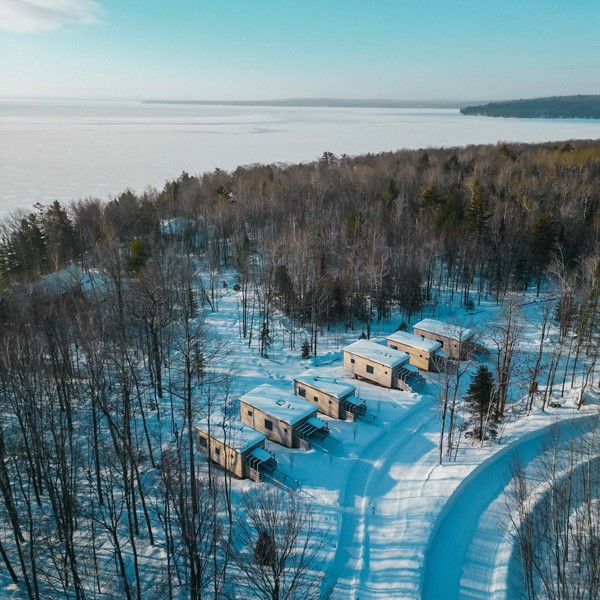
Camping the Lower Wisconsin River
Pull your canoe onto a sandbar surrounded by the waters of the state’s biggest river and watch American Bald Eagles soar. That’s just one scenario awaiting paddlers along the Lower Wisconsin River, a 92 mile stretch of free-flowing river between Prairie Du Sac and Prairie Du Chein.
With nearly 80,000 acres of government protected river, bluffs, islands and flood plains, paddlers have endless opportunities to camp, hike, fish and observe an astounding population of birdlife. Because this lower portion of the Wisconsin River is not dammed and because there are no rapids, it’s a great corridor for paddlers of most experience levels—especially for those who want to soak up the scenery while expending the least amount of energy.
Whether visitors are pitching a tent for the maximum-allowed, three-day campsite stay, or just stopping for respite while passing through, sandbars are the joy of the Lower Wisconsin River. Other than no glass use and snuffing out fire pit ash responsibly, there are few restrictions, but there are DNR river ethics. What are they? Have a good time. Pick up after yourself. Respect others.
The DNR also has great safety tips to address strong currents and sandbar dropoffs. All good things to keep in mind for a safe and fun trip on the river.
This is a beautiful nine mile stretch where paddlers can launch at Tower Hill State Park in Spring Green and have transportation waiting in Lone Rock just east of the Hwy 130 bridge. Wooded bluffs with beautiful limestone and sandstone outcroppings lie along the south side of this downstream excursion; some even rise right out of the river. If you plan the four to five hour trip just right, you can return to Spring Green in time to catch dinner at the Taliesin Riverside Café or Wisconsin Riverside Resort, two spots where you can dine and watch the river run.
Lone Rock to Muscoda
From Lone Rock, head to Muscoda—Wisconsin’s Morel Capital—for a 13 mile trip past more beautiful bluffs and with plenty of off-water attractions rich with Wisconsin history. Campers have the option of finding a spot along one of the many iconic sandbars or setting up camp at the Victoria Riverside Park. Here you can pitch a big, comfy tent and take a shower and still wake to the sounds of waterfowl and shoreline birds within the river’s well-managed natural and wildlife areas. Paddle the river in May and take in the Muscoda Morel Festival. You can also get an Effigy Mounds Grand Tour map and visit Native American burial sites that are a thousand years old and view Ho-Chunk bison placed along the river to protect these sacred grounds. Stop at the Avoca Prairie, a combination prairie, uplands and marshy area, where its distinct beauty is in its details. The trip is quiet and at some points the landscape is thought to appear much like it did before Wisconsin’s first human inhabitants.
Boscobel to Wyalusing
Begin at Boscobel and head south to Wyalusing State Park, downstream on the Mississippi from Prairie Du Chien, a 31 mile paddle down the most secluded and serene stretch of the Lower Wisconsin River. You can first (or last) explore the Boscobel Bluffs, a 389-acre property owned and protected by the Mississippi Valley Conservancy, camp the sandbars for two nights, and end your journey at Wyalusing State Park, where the Wisconsin and Mississippi Rivers meet at a beautiful and historic confluence. Outfitters like Wisconsin River Outings in Boscobel and The Wisconsin Canoe Company in Spring Green rent canoes and kayaks and provide car shuttles, so your car will be waiting for you when you land.
With nearly 80,000 acres of government protected river, bluffs, islands and flood plains, paddlers have endless opportunities to camp, hike, fish and observe an astounding population of birdlife. Because this lower portion of the Wisconsin River is not dammed and because there are no rapids, it’s a great corridor for paddlers of most experience levels—especially for those who want to soak up the scenery while expending the least amount of energy.
Whether visitors are pitching a tent for the maximum-allowed, three-day campsite stay, or just stopping for respite while passing through, sandbars are the joy of the Lower Wisconsin River. Other than no glass use and snuffing out fire pit ash responsibly, there are few restrictions, but there are DNR river ethics. What are they? Have a good time. Pick up after yourself. Respect others.
The DNR also has great safety tips to address strong currents and sandbar dropoffs. All good things to keep in mind for a safe and fun trip on the river.
This is a beautiful nine mile stretch where paddlers can launch at Tower Hill State Park in Spring Green and have transportation waiting in Lone Rock just east of the Hwy 130 bridge. Wooded bluffs with beautiful limestone and sandstone outcroppings lie along the south side of this downstream excursion; some even rise right out of the river. If you plan the four to five hour trip just right, you can return to Spring Green in time to catch dinner at the Taliesin Riverside Café or Wisconsin Riverside Resort, two spots where you can dine and watch the river run.
Lone Rock to Muscoda
From Lone Rock, head to Muscoda—Wisconsin’s Morel Capital—for a 13 mile trip past more beautiful bluffs and with plenty of off-water attractions rich with Wisconsin history. Campers have the option of finding a spot along one of the many iconic sandbars or setting up camp at the Victoria Riverside Park. Here you can pitch a big, comfy tent and take a shower and still wake to the sounds of waterfowl and shoreline birds within the river’s well-managed natural and wildlife areas. Paddle the river in May and take in the Muscoda Morel Festival. You can also get an Effigy Mounds Grand Tour map and visit Native American burial sites that are a thousand years old and view Ho-Chunk bison placed along the river to protect these sacred grounds. Stop at the Avoca Prairie, a combination prairie, uplands and marshy area, where its distinct beauty is in its details. The trip is quiet and at some points the landscape is thought to appear much like it did before Wisconsin’s first human inhabitants.
Boscobel to Wyalusing
Begin at Boscobel and head south to Wyalusing State Park, downstream on the Mississippi from Prairie Du Chien, a 31 mile paddle down the most secluded and serene stretch of the Lower Wisconsin River. You can first (or last) explore the Boscobel Bluffs, a 389-acre property owned and protected by the Mississippi Valley Conservancy, camp the sandbars for two nights, and end your journey at Wyalusing State Park, where the Wisconsin and Mississippi Rivers meet at a beautiful and historic confluence. Outfitters like Wisconsin River Outings in Boscobel and The Wisconsin Canoe Company in Spring Green rent canoes and kayaks and provide car shuttles, so your car will be waiting for you when you land.
Deals










